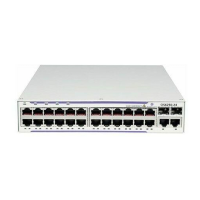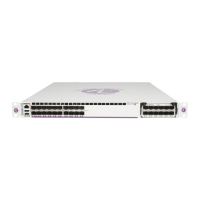Configuring Server Load Balancing Configuring Server Load Balancing on a Switch
OmniSwitch AOS Release 8 Network Configuration Guide December 2017 page 24-11
Configuring and Deleting SLB Clusters
The following subsections describe how to configure and delete SLB clusters with the ip slb cluster
command.
Configuring an SLB Cluster with a VIP Address
Consider the following when configuring a VIP cluster:
• Specify a cluster name that is at least 1 character and less than or equal to 23 characters long.
• To use spaces in an SLB cluster name, enclose the entire name within quotation marks (for example,
“web server”).
• The VIP address of the SLB cluster must be an address in the same subnet as the servers.
• VIP only supports the Layer-3 SLB mode, which is enabled by default.
• The VIP method for directing traffic to the cluster servers is supported on an MCLAG configuration.
To configure an SLB cluster that uses VIP classification to bridge or route client requests to the cluster
servers, use the ip slb cluster command with the vip parameter. For example, to configure an SLB cluster
called “Web_Server” with a VIP address of 10.123.11.14, you would enter:
-> ip slb cluster Web_Server vip 10.123.11.14
Configuring an SLB Cluster with a QoS Policy Condition
Consider the following when configuring a QoS policy condition cluster:
• Specify a cluster name that is at least 1 character and less than or equal to 23 characters long.
• To use spaces in an SLB cluster name, enclose the entire name within quotation marks (for example,
“web server2”).
• The QoS policy condition name specified must the switch configuration.
• The QoS policy condition method for directing traffic to the cluster servers is not supported on an
MCLAG configuration.
To configure an SLB cluster that uses a QoS policy condition to qualify client requests for bridging or
routing to the cluster servers, use the ip slb cluster command with the condition parameter and either the
l2 or l3 parameter. For example, to configure an SLB cluster called “Web_Server2” with the “cond1”
policy condition and using the L2 mode, you would enter:
-> ip slb cluster Web_Server2 condition cond1 l2
How to Create a QoS Policy Condition
Use the policy condition command to create a QoS policy condition. For example, the following
command creates a source port condition named “cond1”:
-> policy condition cond1 source port 1/24
Note. Even though they use the same name, the SLB VIP address and the Multi-Chassis Link Aggregation
(MCLAG) VLAN Virtual IP (VIP) address must be different on the MC-LAG setup. The MCLAG VIP
provides a common IP address for the multi-chassis peer switches; the SLB VIP provides a common IP
address for the SLB cluster.

